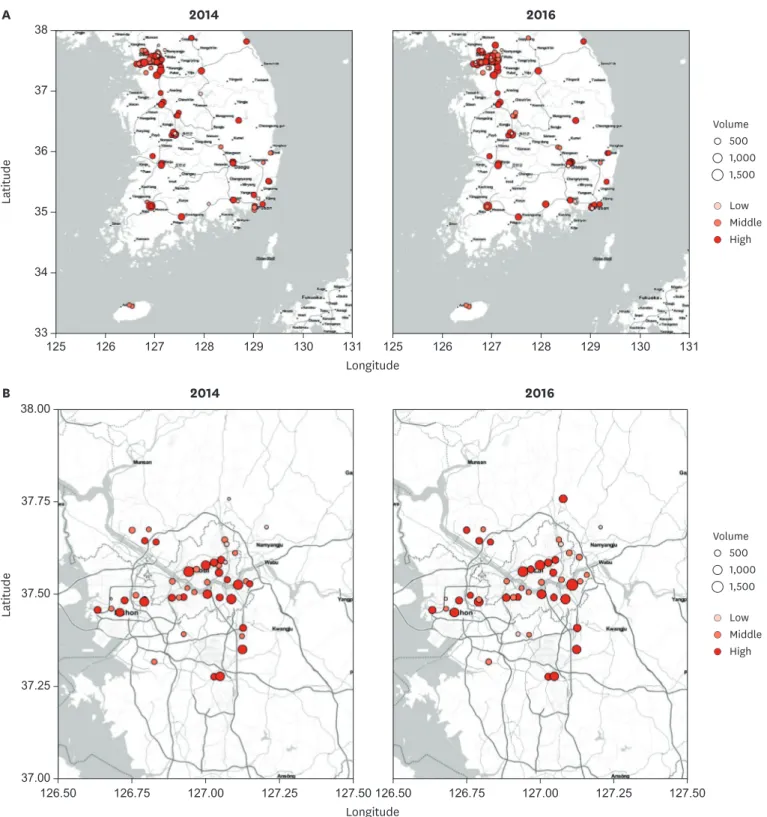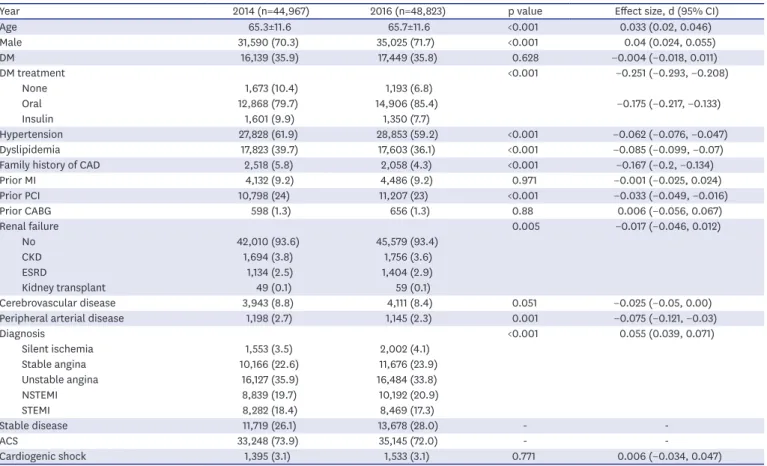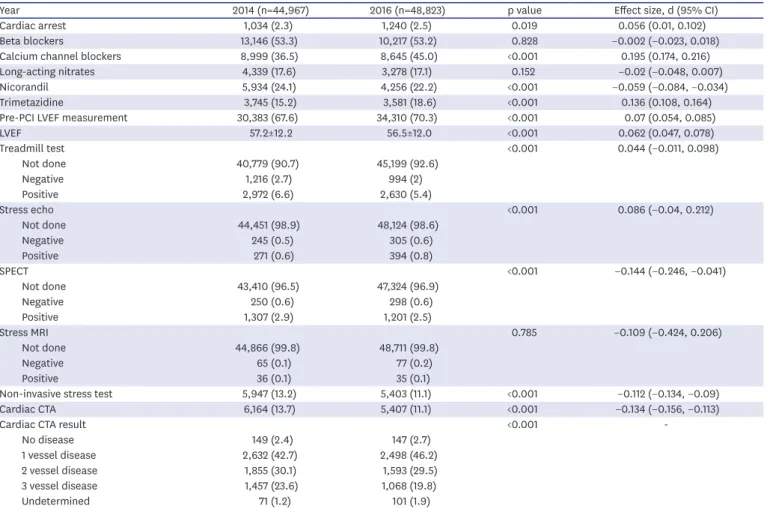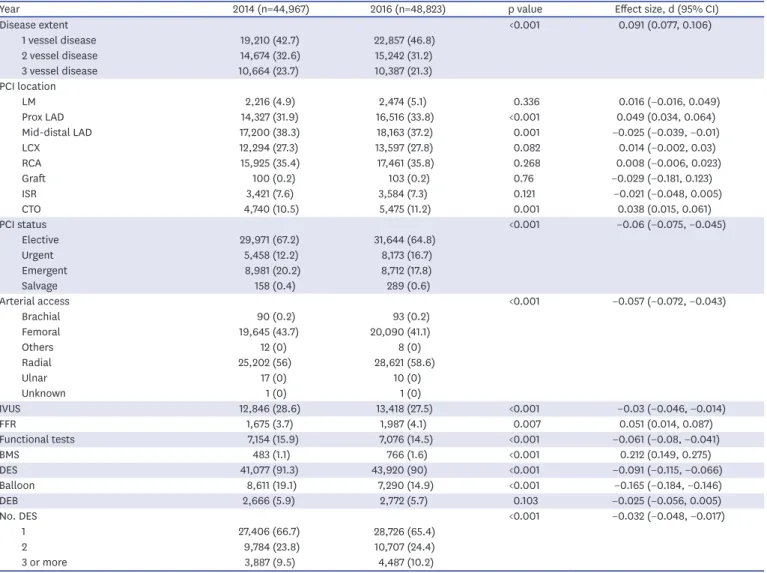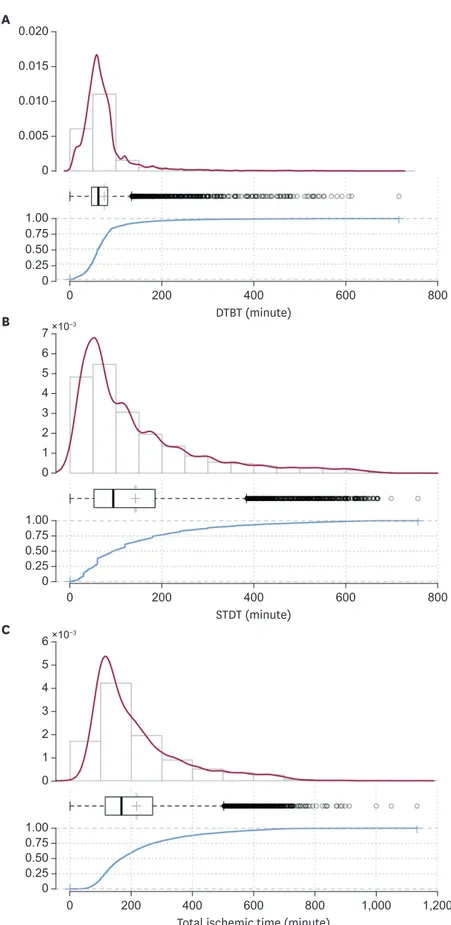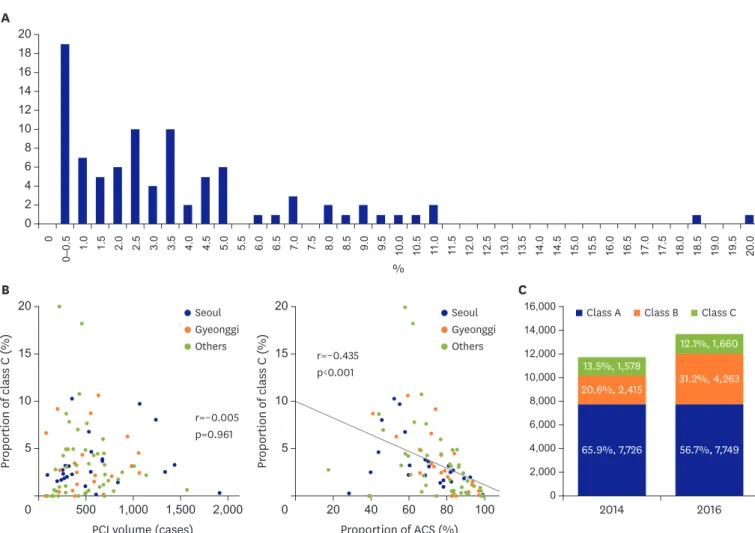ABSTRACT
Background and objectives: In this second report from Korean percutaneous coronary intervention (K-PCI) registry, we sought to describe the updated information of PCI practices and Korean practice pattern of PCI (KP3).
Methods: In addition to K-PCI registry of 2014, new cohort of 2016 from 92 participating centers was appended. Demographic and procedural information, as well as in-hospital outcomes, of PCI was collected using a web-based reporting system. KP3 class C was defined as any strategy with less evidence from randomized trials and more aggressive for PCI than medical therapy or bypass-surgery.
Results: In 2016, total 48,823 PCI procedures were performed at 92 participating centers.
Mean age of the patients was 65.7±11.6 years, and 71.7% were males. Overall patient characteristics and PCI practices in 2016 were similar to those in 2014. The biggest change
Original Article
Received: Nov 12, 2018 Revised: May 16, 2019 Accepted: Jun 5, 2019 Correspondence to Keon-Woong Moon, MD
Department of Internal Medicine, St. Vincent's Hospital, The Catholic University of Korea, 93 Jungbu-daero, Paldal-gu, Suwon 16247, Korea.
E-mail: cardiomoon@gmail.com
*Dong-Ho Shin and Hyun-Jae Kang contributed equally to this work as co-first authors.
Copyright © 2019. The Korean Society of Cardiology
This is an Open Access article distributed under the terms of the Creative Commons Attribution Non-Commercial License (https://
creativecommons.org/licenses/by-nc/4.0) which permits unrestricted noncommercial use, distribution, and reproduction in any medium, provided the original work is properly cited.
ORCID iDs Dong-Ho Shin
https://orcid.org/0000-0002-7874-5542 Hyun-Jae Kang
https://orcid.org/0000-0002-3500-1746 Jae-Sik Jang
https://orcid.org/0000-0001-7865-124X Keon-Woong Moon
https://orcid.org/0000-0003-2726-3209 Young Bin Song
https://orcid.org/0000-0003-3986-9152 Duk-Woo Park
https://orcid.org/0000-0001-6643-0239 Jang-Whan Bae
https://orcid.org/0000-0003-1362-9804
Dong-Ho Shin , MD, DrPH 1,* , Hyun-Jae Kang , MD 2,* , Jae-Sik Jang , MD 3 , Keon-Woong Moon , MD 4 , Young Bin Song , MD 5 , Duk-Woo Park , MD 6 , Jang-Whan Bae , MD 7 , Juhan Kim, MD 8 , Seung-Ho Hur , MD 9 ,
Byung Ok Kim , MD 10 , Dong Woon Jeon, MD 11 , Donghoon Choi , MD 12 , and Kyoo-Rok Han , MD 13
1
Department of Internal Medicine, Severance Hospital, Yonsei University College of Medicine, Seoul, Korea
2
Department of Internal Medicine, Seoul National University Hospital, Seoul, Korea
3
Division of Cardiology, Department of Internal Medicine, Busan Paik Hospital, University of Inje College of Medicine, Busan, Korea
4
Department of Internal Medicine, St. Vincent's Hospital, The Catholic University of Korea, Suwon, Korea
5
Division of Cardiology, Department of Medicine, Samsung Medical Center, Sungkyunkwan University School of Medicine, Seoul, Korea
6
Department of Cardiology, Asan Medical Center, University of Ulsan College of Medicine, Seoul, Korea
7
Department of Internal Medicine, Chungbuk National University College of Medicine, Cheongju, Korea
8
Department of Cardiovascular Medicine, Heart Center of Chonnam National University Hospital, Gwangju, Korea
9
Division of Cardiology, Department of Internal Medicine, Keimyung University Dongsan Medical Center, Daegu, Korea
10
Division of Cardiology, Department of Internal Medicine, Sanggye-Paik Hospital, University of Inje College of Medicine, Seoul, Korea
11
Department of Cardiology, National Health Insurance Service (NHIS) Ilsan Hospital, Goyang, Korea
12
Division of Cardiology, Department of Internal Medicine, Severance Cardiovascular Hospital, Yonsei University College of Medicine, Seoul, Korea
13
